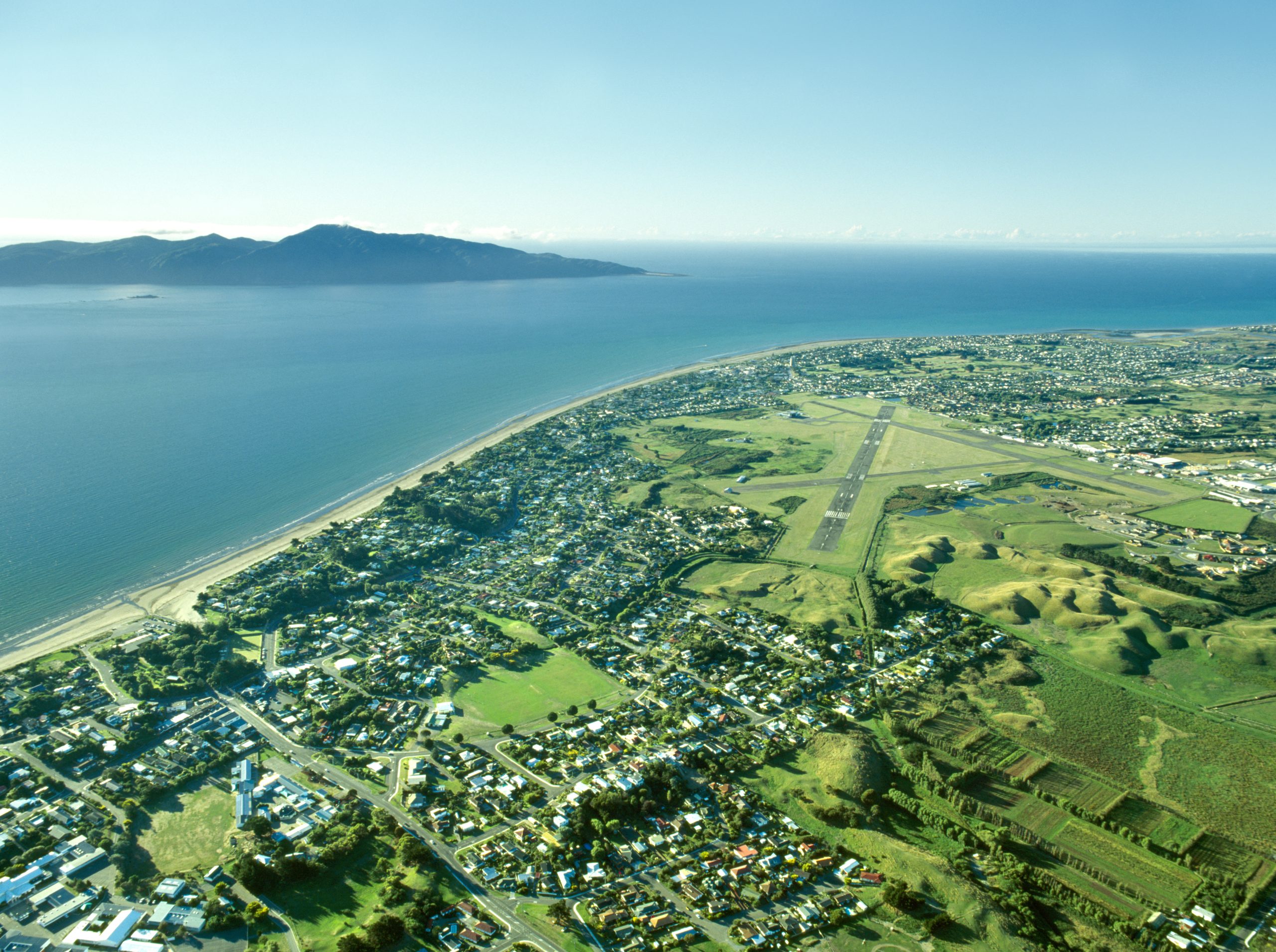
Te Moana Road in Waikanae – the main road, leading from the mountains and motorway to the sea – is beautiful. It is lined with native and deciduous trees, bursting in spring with pink popcorn cherry blossom, and sprinkled with walkers and cyclists travelling to and from the shops, beach, swimming pool or Waikanae River.
Just south of Waikanae is Paraparaumu. Those who don’t often venture in recognise it by the buffet of fast-food outlets along State Highway 1 (SH1), including Burger King, McDonald’s, KFC and Wendy’s. Paraparaumu’s equivalent of Te Moana Road is Kapiti Road. Heading west along it on a clear day, Kapiti Island looks just a stone’s throw away. Otherwise, the view is filled with big-box retailers, a petrol station, gorse, logpiles and the airport.
“Kapiti Road should be like Te Moana Road,” says Kapiti Coast District Council (KCDC) councillor and columnist K. Gurunathan, explaining that Te Moana was planned to be green. “You look at Christchurch: it was planned. You look at Palmerston North: it was planned.”
So why isn’t Kapiti Road more like Te Moana? “Flat earth,” he says. Paraparaumu’s geography allows property developers to purchase multiple lots for rents that reach around $1 million per year. “So they need ‘anchor tenants’, which are largely big-box type… Some time in the future, 20 years from now, this [Kapiti Road land] will all be filled up. If we believe in growth, that is.” By “growth”, Gurunathan appears to mean the economic kind, the trajectory of which is ever challenging to predict.
Currently, airport landowners Todd Property Group and Kapiti Landing director Noel Robinson want council regulation relaxed to develop the Kapiti Landing Business Park (KLBP) on the airport zone. The council’s Development Plan prevents this area from becoming a ‘centre’, to protect the current civic centre opposite Coastlands shopping centre. The plan ensures “retail and commercial activities undertaken within the [airport] Precinct do not have adverse effects on the centre’s hierarchy”.
KLBP’s website boasts plans for a $5 million airport upgrade on 300,000 square metres of developable area. The land comes with a promised 8,000 new jobs, including 5,000 full-time equivalent (FTE), all overseen by “one proud owner”. Restaurants, cafés, cycleways and walkways, “outdoor artworks”, parks, possible public amenities and more than 4,000 car parking spaces are also on the drawing board.
KLBP evolved from a privately initiated KCDC Development Plan change (Plan Change 73). This came before the council in 2006, when it was “was hotly contested”, according to KCDC. Debates, hearings, close votes and an environment court appeal resulted in a 2009 agreement to make the plan change operative. The District Plan Review is currently underway, with KCDC receiving submissions on this issue.

Economic development is a KCDC priority, yet it is not clear if KCDC seeks the kind of development Porirua and Palmerston North have undergone. The Long Term Plan 2012–2032 states: “Job creation (particularly smart job creation), wealth attraction and some lessening of dependence on other parts of the region, country and world will better secure the future of Kapiti residents.” Smart jobs are defined as being “part of the new, low-carbon economy which adds value to basic commodities and materials produced in the area”. KCDC adds that they are keen to secure plenty of local employment for young people, and KLBP’s New World has seen three to four applicants applying for every job available.
“The Todd Group’s massive,” says Gurunathan. “They can develop some amazing things down there. They’ve got the money… [but] the current rule favours Coastlands. It’s called a ‘centre-based approach’. It’s urban planning.”
When Coastlands was established in the 1970s, it shifted Paraparaumu’s then-centre from the beach. “So basically the heart of the community was a mall,” says Gurunathan. The library was then built, and this year, Coastlands and Pak’nSave helped fund the new council building and aqua centre. Since they want the foot traffic, they contribute to the civic centre development crucial to Kapiti’s expansion.
Coastlands chief executive Richard Mansell says that “Todd Property Group bought the development with a set of rules covering it. Those rules have been sorted out between the former owner, Noel Robinson, and the community over about a three-year period… [Now] they want to change the rules that they bought it under. I can see why they’d want to, but it’s a matter of somebody with rather deep pockets coming in and bullying. What they’ve said is, ‘Do what we want, or we’ll take our money and go elsewhere.’”
Paraparaumu Beach Business Association (PBBA) chair Warwick Halcrow says the airport precinct’s new Smiths City, New World and Kitchen Things may adversely affect business at the Beach Four Square, butcher, pharmacy, Lotto and homeware stores. “Everywhere you look, that’s the case in New Zealand,” says Halcrow on the effect of these large “category killers”.
While Kapiti Chamber of Commerce (KCC) chair Mark Ternent says that the “movement of business and jobs from place to place” is part of economic growth, KCDC requires development to add to what is already offered in the region. Halcrow says, “We don’t want to see, at the airport, a replication of what already exists in Kapiti… and to a degree that’s all they’ve actually achieved so far. All they’ve done is build big-box stores; they’re going to shift customers and jobs from one place to another. So, hopefully we start to see the promise in much publicised growth in high-value, smart businesses coming in and opening up.”
Halcrow says Todd Group is also planning a farmer’s market, “which is looking like it’s potentially going to go head to head with our regular Saturday market”. The successful beach market has attracted a lot of customers for 13 years. “So we struggle to understand the logic of that. The PBBA want to see growth in the market on the beach.” Halcrow says the market provides a chance for grassroots business to start up. For $20 a week, stallholders can “go and see if their product will fly”. Thoroughbread, among “the best gluten-free bread in the country”, is a major brand now, having started at the market.
“We’re trying to find out what they’re actually proposing, but at the moment no one can tell us,” Says Halcrow. On being asked for more detailed plans, Robinson called it “very improper to talk about these things through the press”. But Ternent says Kapiti would not be harmed by the competition large-format retail represents as “it spurs innovation”. To ensure their “slice of the pie… businesses have to work harder,” he says, adding that “if consumers want to have locally produced products, then they have to buy them… consumers need to look at themselves in the mirror”.
Despite the potential threat Todd Group poses to beach businesses, Halcrow still thinks “the benefits outweigh the negatives on the whole”. On the beach, “you’ve got a very large selection of food, cafés, restaurants, and you’ve also got more boutique kind of shopping”. Paraparaumu Beach already offers accountants, solicitors, real estate agents, mortgage brokers, financial advisers and architects, and may develop as a hub for niche businesses and services. The council’s recent upgrade of the beachfront, the airport’s extra flights to and from Christchurch, and a hoped for transformation of the Kapiti Boating Club into a Kapiti Island visitor centre should also support the growth of a tourist industry.
“It’s a nice place to have an office,” Halcrow says, adding that if the “promised higher-paying jobs materialise… they’ll be the sort of people who will want a nice house by the beach… This is a very desirable area to live. It’s got good amenities, the beach, park, schools are good – it’s just a pleasant place to live.”
Save Kapiti’s Bianca Begovich laments DOC’s prices for Kapiti Island visits becoming “unreachable for the normal New Zealander” in favour of capitalising on tourism. Her home sits among a collection of empty lots in Waikanae designed by John Smith as an eco-development among expressway-threatened wetlands. “We didn’t come here or stay here because we want to go shopping or catch aeroplanes,” she says.
To her, the airport and Kapiti Expressway development plans will also see increased congestion on Kapiti Road, further splitting Paraparaumu between its west and east sides. So will development see Paraparaumu becoming gentrified, leaving those ‘over the tracks’ in the wake of tourist boats making pricey trips to Kapiti and freight trucks on a noisy motorway?
The 16-kilometre, four-lane expressway route from MacKays Crossing to Peka Peka is a $50 million project, according to KCDC – or $630 million, according to Campbell Live’s 2012 story ‘A very expensive stretch of road’. It includes three bridges, and “will definitely bring massive changes that will be quite uncomfortable for people over the next 4–5 years,” according to KCDC.
“We believe the expressway will really divide the district into two halves,” says Halcrow. “It already is now, east of the existing highway and railway lines… what you’ll get as far as shopping goes is probably a concentration of eastern residents on that side, and a concentration of western residents on this side… the demographics will kind of sort themselves out.”
Expressway plans include a major interchange up and over Kapiti Road. “I don’t know how the traffic geniuses have got that one sorted,” says Halcrow. “Because already Kapiti Road gets highly congested and has a traffic count very similar if not greater than State Highway 1.” On the brighter side, he says perhaps beach customers will become more loyal as they won’t want to bother with interchange traffic.
Kapiti Landing director Noel Robinson is a supporter of the expressway because it is what the “experts” (the New Zealand Transport Agency, NZTA) recommend, and he and Ternent are both enthusiastic about the promised growth. According to Gurunathan, the interchange will shift the town centre “towards the airport. So that’s why Noel Robinson thinks the expressway is the best thing to happen in the whole world.”
Save Kapiti secretary Mark Harris explains that Steven Joyce rekindled expressway plans in 2009, after a New Zealand Council for Infrastructure Development submission resulted in the planning of a nationwide roading project in the interests of roading construction. The nationwide Roads of National Significance plan pushed the Western Link Road (WLR) off the table. The WLR had been in the District Plan for some years, had been consented through several rounds of legal action, and much of the land had been bought.
In August, Save Kapiti lost an appeal against the expressway in the High Court. They are awaiting approval for a Supreme Court appeal on the basis that the government has not assessed expressway plans sufficiently against the more socially and environmentally responsible WLR.
The WLR was co-designed by urban planner James Lunday in the 1990s on the principle that “You don’t build a road and then fit your communities into the road. You look at your communities, and then you fit your road around that,” says Gurunathan.
So the WLR was designed with fewer lanes, lower speed limits, cycleways, bridleways and walkways. It was not a straight road designed for freight, which Begovich suggests should go on rail. KCDC have negotiated over 300 expressway conditions, from environmental protection to noise mitigation and the development of cycleways, “but you don’t want to cycle along SH1,” says Begovich, who adds that the WLR had “areas for food growing, business spaces – all kind of opportunities to have a community-based development”.
The expressway was first designed in the 1950s to alleviate traffic congestion and provide an emergency alternative route to State Highway 1. This was a time when motorways were good for economies. “Of course, by 1996,” says Begovich, “another whacking great motorway through a seaside community didn’t seem such a good idea.” Begovich says the NZTA itself called the expressway designs – which pass through a tapu burial site, nationally significant wetlands and many residential homes – “unnecessary”, “outdated”, “socially divisive” and “poor urban planning”.
KCDC says the expressway promises 500 FTE jobs, many for more than four to five years, “and quite a number of people expected to live up here while they work on the project”. Begovich says the WLR offered 4,000 jobs: “not just build it, plant it and leave, but 4,000 ongoing jobs”. She adds that the chain of fast-food outlets along SH1, “at the likes of Te Moana Road, that’s the development we’re going to get with the expressway. That’s what motorways bring.” Perhaps not “smart” development as defined in KCDC’s Development Plans.
Kapiti’s mayor, Jenny Rowan, previously called the expressway the “highway from hell”, and now says the process “has been very difficult for people, and at times traumatic. I am very respectful of the views of Save Kapiti and the Alliance for a Sustainable Kapiti, and acknowledge the work they’ve put into this issue. However, it’s now time to let NZTA get on with the job, and for us to focus on getting the very best we can out of the project.”
Todd Group has stated that the region needs to “clearly demonstrate that Kapiti is open for business”. It is clear what this means for property investors and NZTA, but parts of the council and community appear to have other ideas. “If your urban design is age-friendly, it’s automatically family-friendly,” says Gurunathan, adding that becoming age-friendly constitutes “an unrealised potential for shaping the community that we want”.
The last hearing for KCDC’s District Plan takes place in May 2014, and the government will want Save Kapiti’s Supreme Court appeal over and done with before election time, if it takes place. In the next 18 months the shift of Paraparaumu’s main bustle shift to the airport zone, where the major motorway interchange is likely to be built, could begin. Only time will tell whether these long struggles will ultimately deliver the best results for Paraparaumu and the wider Kapiti region.






